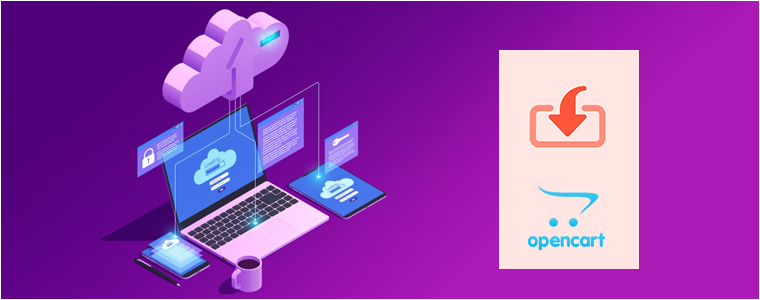Introduction
In today’s internet world, almost each & every task is possible by using a computer, and shopping is one of them. eCommerce has become a giant industry with a global valuation of nearly 3.5 trillion dollars in 2019. It is having a presence everywhere from selling toothpaste to technical equipment, furniture, insurance policies, etc.
The global online retail sales figure is expected to reach 17.5% in 2021. B2B alone is expected to reach a valuation of $6.6 trillion by 2020. However, due to the coronavirus pandemic, these stats can now vary. You wouldn’t believe that the total number of ecommerce web applications across the world lies between 2-3 million. There is no wonder of such a huge number, as more and more consumers are getting used to buying online. Also, starting an ecommerce business doesn’t require such a huge investment, unlike the traditional brick-and-mortar stores.
Content table
-
Introduction
-
OpenCart :
-
Get A Domain & Hosting:
-
Download & Install OpenCart:
-
Install A Theme:
-
Upload The Products:
-
Additional Functionalities Using Extensions:
OpenCart
OpenCart is renowned platform in the ecommerce industry. Developers have done great work to make it a reliable and robust platform for online stores. The online store management system is written in PHP scripting language, which uses MySQL database, so nothing new there.
OpenCart can run on any ecommerce hosting environment with PHP 5.4 or above, MySQL database, minimum 500MB of free space (store size is dependent on the number of categories, products, and images) and Apache Server mod_rewrite module.
OpenCart also requires few PHP libraries/modules including Curl, ZIP, Zlib, GD Library, Mcrypt, Mbstrings, and XML. It is recommended that the above system requirements should always be available at your hosting provider. During the installation process, OpenCart will check for all of these requirements. You should contact your hosting provider if any of these is missing.
1. Get A Domain & Hosting:
The benefit of having your own website is the option to have your own unique web address. For example, Facebook has its web address i.e. facebook.com. Having your choice of domain name helps you build a better brand reputation. It also provides you with all possible kinds of marketing opportunities. You also get a better hold of getting deeper insights into your audiences & customers. This allows you to improve your services by following a customer-centric approach & it all eventually boosts your revenue & helps your business thrive.
The first step you need to take is to buy a domain name & a suitable hosting (shared/ VPS, dedicated, cloud hosting, etc.) according to your needs. Once you get a hosting space, you can install & design your OpenCart website on it.
Alternatively, you can design your OpenCart website on your local computer (using Xampp/ Wamp/ Mamp) & then later upload your well-designed OpenCart website to your domain & hosting space.
2. Download & Install OpenCart:
Download the latest version of OpenCart from the official website of OpenCart. Upload the downloaded file on your hosting space (usually the public_html folder of the cPanel of your Linux Hosting). Then simply set up the database (MySQL for OpenCart), connect it with your OpenCart website & run the installation.
Viola! Now, you can easily sign-in to the backend of your website & design your site. OpenCart has a very flexible yet easy to use backend with features that even a non-tech savvy person can use.
3. Install A Theme:
OpenCart has a number of theme templates that already are mobile-responsive & customizable to every extent. Choose the one that suits your business needs. You can also design your own theme from scratch or heavily customize an existing theme as per your needs & budget. You can even outsource the OpenCart development & hosting task to a professional eCommerce firm.
4. Upload The Products:
No eCommerce website can function without the products being listed on it. Simply add the products & enter the relevant description, price, tax rules, delivery fees, etc. You can also upload the products in bulk using the ‘.csv’ file upload method.
5. Additional Functionalities Using Extensions:
To add more designs & functions other than what your theme offers, you can install 3rd party extensions on your OpenCart website. Some of the common OpenCart extensions are ‘One-Page Checkout’ extension, ‘ZIP code product availability check’ extension, ‘Mobile App Builder’ extension, etc.
6. Payment & Shipment Configuration:
Set up the payment methods according to the popularity among your potential audience. The easiest one to set up is PayPal. You can also add payment options using Credit/ Debit cards, eWallets, Net Banking, Pay-On-Delivery, etc.
Next, you must set up the shipment. The most popular shipment companies are FedEx, DHL, etc. Based on your business location & the location of your target audiences, make sure to choose relevant shipment companies.
These are all the minimum steps you would need to get your OpenCart eCommerce website up & running. Later on, you can make any desired modifications on your OpenCart site whenever you need it.
From the backend of your OpenCart website, you can manage orders, add site managers/ editors with selective privilege, add CMS pages like ‘about-us’, ‘privacy policy’, etc.
OpenCart can also be used by brick & mortar shops to simply display their products like a catalog website (without setting payment & shipment options). This can help them build a better online presence with improved branding. Those who sell products via affiliate links can also build a catalog website using OpenCart. The options with OpenCart are just endless.
We, at Digitsmark, offer OpenCart plugins along with website development and designing services. Check out the following ones as they can be used to offer more for your business:
- Launch Native Apps with OpenCart Mobile App Builder
- Create an online marketplace on the website with OpenCart Multi-vendor Marketplace.
- Connect your PrestaShop website to third party marketplace like eBay, Etsy, Walmart, etc. with Marketplace Integrators.













